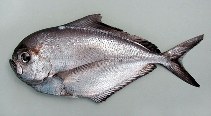| Family: |
Bramidae (Pomfrets) |
| Max. size: |
22.5 cm SL (male/unsexed) |
| Environment: |
pelagic-neritic; marine; depth range 1 - 300 m, oceanodromous |
| Distribution: |
Circumtropical. Western Indian Ocean: East Africa to India, between the Equator and 10°S, Mozambique Channel, Seychelles, and Madagascar. Eastern Indian Ocean: Indonesia (Ref. 5978) and Western Australia (Ref. 49596). Western Atlantic: Florida and northern Gulf of Mexico in USA to Brazil (Ref. 7251). Eastern Atlantic: 20°N to 20°S (Ref. 4936). Eastern Pacific: Guatemala to Peru (Ref. 9282) and Chile (Ref. 27363). |
| Diagnosis: |
Dorsal spines (total): 0-0; Dorsal soft rays (total): 32-35; Anal spines: 0-0; Anal soft rays: 25-28; Vertebrae: 39-43. Pectoral fins situated relatively low on body in juveniles. The distance between the base of the lowermost pectoral ray and the pelvic fin insertion less than 42% of head length (Ref. 559). |
| Biology: |
Found near the edge of the continental shelf. Appears to spawn all year-round. Marketed fresh, and eaten fried. |
| IUCN Red List Status: |
Least Concern (LC); Date assessed: 04 February 2009 Ref. (130435)
|
| Threat to humans: |
harmless |
Source and more info: www.fishbase.org. For personal, classroom, and other internal use only. Not for publication.
